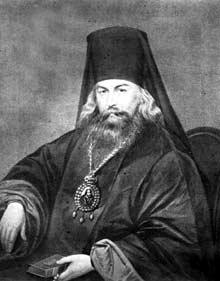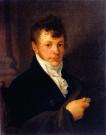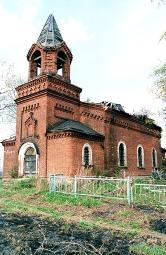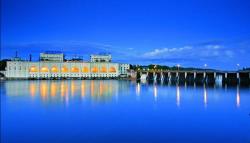Articles
/
Staraya Ladoga Dormition Convent, the
Staraya Ladoga Dormition Convent, the
Subject /
Religion. Church/Monasteries and convents
The Staraya Ladoga Dormition Convent (the Volkhov district, the village of Staraya Ladoga) is one the most ancient monasteries in the St. Petersburg Eparchy. It was presumably founded in the first quarter of the 12th century as a prince's convent on a territory which was not defended by a fortress from Varangians' forays from the North. The consiliar church of the Dormition (it was built between 1154 and 1158 or in the second quarter of the 12th century / 1143-1153?/) is the oldest in the eparchy. It is single-domed triapsidal temple of 20 metres high, of cube shape, with zakomara (vault) roofing; fragments of the painting has been survived. The church was the centre of the Ladoga Town Bogoroditsky end. In 1617 the convent was brought in ruin by Swedes; in the same year the vonvent was renewed by the elderly nun Aquilina who joined the territory of the abolished monastery of St. Simeon to the convent. The convent was burned on 24 February 1702 and completely rebuilt only by 1727. During 1718-1725 the convent was the place of staying the nun Helen (Yevdokia Lopukhina), the former wife of Peter I who visited the convent more than once. During about ten years the Smolny Convent of the Resurection was included into the convent. In 1764 the convent was graded as the 3d class convent; during that years the cathedral had the side-chapel of the Annunciation (1761) and the side-chapel of Sr. Barbara the Great Martyr, 12 wooden cells and the stone bell tower (1762). The hegumenness Euphrasia was the most famous superioress (1779-1823). Under the hegumenness Febronia in 1823-1825 the fence was built, in 1831-1833 the side-chapel of the Annunciation was enlarged, the single-domed cemetery church of St. Alexy the man of God was built, in 1836-1843 a stone cell building was constructed, in 1853 the wooden apartment for the superioress was built. Under the hegumenness Dionissia some buildings were built: side-chapels of the Cathedral in the name of the Kazan Icon of the Mother of God (1856) and of St. Barbara (1855, it has not survived); the two-storied stone refectory building, a hotel and the fence (1858-1859), a hotel, a hospital in the Russian style of the 17th century with the church of the Exaltation of the Holy Cross (1860-1862, the architect A.M. Gornostayev) on the place of the church of the Convent of St. Simeon which was brought in ruin by Swedes. In the early 20th century 200 nuns lived in the convent and they carried on extensive economy. There were two miracle-working icons: the icon of the Dormition and the icon of St. Barbara the Great Martyr. The family of landowners Tomilovs, the merchants Lukovitskys from Novaya Ladoga, Baroness M.V. von Raden were among the greatest benefactors. The spiritual writer hieronun Maria (Shakhova), a spiritual daughter of St. Ignaty (Bryanchaninov), lived in the convent. The painter B.M. Kustodiyev worked there. The convent was closed in 1919, cathedrals worked as parish ones. In 1925 the Cathedral of the Dormition was closed, the church of the Exaltation of the Holy Cross (it was adapted for a gym) and the church St. Alexy were closed in 1939. The inner decoration has been completely lost, the cemetery was destroyed (only some headstones have survived), side-chapels and and the bell tower of the cathedral were demolished during restoration of 1958-1960. A boarding school was placed on the territory. In 2005 the nun community (it has been being since 2002) got the status of the convent officially. Buildings, besides the Dormition Cathedral and the church of St. Alexy, which were included into the Staraya Ladoga hisorical and architectural museum-reserve, were passed to the St. Petersburg eparchy. Public worships are performed in the church of the Exaltation of the Holy Cross.
Authors
Bertash, Aleksandr Vitalyevich
Persons
Akilina, mother superior
Dionisia, mother superior
Evpraksia (Nakhotinina) (about 1730- 1838), church figure
Fevronia, mother superior
Gornostayev, Vasily Maksimovich
Ignaty (Dmitry Aleksandrovich Bryanchaninov)
Kustodiyev, Boris Mikhaylovich
Lopukhina, Evdikiya Fyodorovna, Tsarina
Lukovitskys , the
Peter I, Emperor
Raden, Maria V. von
Shakhova, Yelisaveta Nikitichna (Maria, nun)
Tomilovs, the
Geography
Historical Toponyms/Ladoga Town
Leningrad Oblast, the/Volkhov District/Staraya Ladoga Village
Bibliography
Корольков Н. Ф. Старо-Ладожский Успенский женский монастырь. СПб., 1902.
Кирпичников А. Н., Сарабьянов В. Д. Старая Ладога – древняя столица Руси. СПб. 1996, С.38-40, 98-99
Subject Index
Eparchy of Saint Petersburg
Staraya Ladoga Historical and Architectural and Archaeological Museum-reserve, the
Mentioned in articles:
|
hidden
|
Gornostayev, Aleksey Maksimovich (1808 - 1862), an architect
Aleksey Maksimovich Gornostayev (1808 - 1862), an architect, a founder of the national line in the Russian arcitecture. In 1834 he was certified at the St. Petersburg Academy of Arts, then he spent 4 years in the West Europe. In 1838 Gornostayev... more
|
|
|
|
hidden
|
Ignaty (Bryanchaninov) (1807-1867), sainted hierach, clergy figure
Ignaty (Dmitry Aleksandrovich Bryanchaninov; 1807-1867), an ecclesiastical writer, theologian, sainted hierach. Dmitry Aleksandrovich Bryanchaninov studied in the Main Engineering College in St. Petersburg from 1822 untill 1827. He was in the first... more
|
|
|
|
hidden
|
Orthodox monasteries
The Othodox monasteries. The oldest monasteries located on the territory of the Leningrad Oblast - the Monastery of the Dormition, the Monastery of St. Nicholas the Wonderworker and the Zastenny Monastery of St. George in Ladoga were founded... more
|
|
|
|
hidden
|
Staraya Ladoga, Village
STARAYA LADOGA (Ladoga before 1704), a village in Volkhov District. Population: 2200. Located on the left bank of the Volkhov River where the Ladozhka (Yelena) River flows into it. The toponym is of a Baltic Finnish origin, from Alodejogi (lower... more
|
|
|
|
hidden
|
Tomilov, Aleksey Romanovich (1779- 1848), landlord
TOMILOV, Aleksey Romanovich (1779–1848, Uspenskoye Village , Novaya Ladoga Uyezd), artillery officer, amateur painter, patron of the arts. In 1799 he supervised fortification works in Kronshtadt Town. In 1808 he resigned. During the 1812 War with... more
|
|
|
|
hidden
|
Town residence of monasteries
The town residences of monasteries. There were two periods of the town residences establising in the St. Petesburg Gubernia/Leningrad Oblast: 1) the late 19th - the early 20th century, 2) the late 20th century. In the period the town residences were... more
|
|
|
hidden
|
Volkhov District
VOLKHOV DISTRICT, a part of Leningrad Oblast. Area: 5124 sq. km, population: 97,300. Established in 1927. Adm. center: Volkhov Town. V. D. comprises the towns of Syasstroy and Novaya Ladoga, and 277 rural localities. Located south of Lake Ladoga on... more
|
|
|
|
hidden
|
Volkhov, town
VOLKHOV, town. Population: 46,600. Located on both sides of the Volkhov River in its lower course. From the 12th century, there was Mikhailovsky Pogost on the site of V. (the 1500 Novgorod scribe roll mentions Archangel Michael’s Church), which,... more
|
|
|
|
hidden
|
Yevpraksia (Nakhotinina) (c.1730-1823), clergy figure
Yevpraksia (Yevdokiya Fyodorovna Nakhotinina; between 1729 and 1734 -1823, the village of Staraya Ladoga), a hegumenness, zealot of godliness. Yevpraksia was born in a merchant 's family, was taught reading and writing. From 1768 Yevpraksia lived... more
|
|
|














